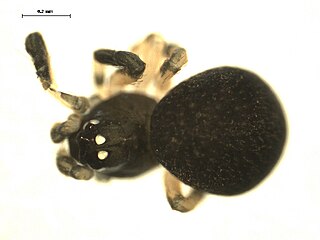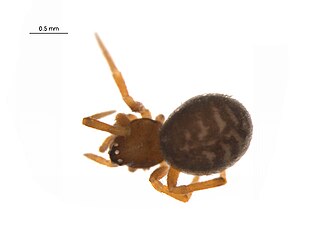
The Pholcidae are a family of araneomorph spiders. The family contains over 1,800 pholcids, including those commonly known as the marbled cellar spider , daddy long-legs spider, granddaddy long-legs spider, carpenter spider, daddy long-legger, vibrating spider, gyrating spider, long daddy, and skull spider. The family, first described by Carl Ludwig Koch in 1850, is divided into 94 genera.

Diaea dorsata is one of the smaller crab spiders, with a palearctic distribution. Females can grow up to 6 mm, males up to 4 mm. Prosoma and legs are green, the opisthosoma is yellowish with a brown mark.

Diaea is a genus of crab spiders first described by Tamerlan Thorell in 1869. Most species are found in specific locations except for D. livens, which occurs both in the United States and D. dorsata, which has a palearctic distribution. Adults are 5 millimetres (0.20 in) to 7 millimetres (0.28 in) and tend to hide in and around vegetation, especially flowers, where their color allows them to blend in to their surroundings.
Foliata, a Latin word meaning leafy, may refer to:
Attinella dorsata is a species of spider from the family Salticidae.

Euryopis is a genus of comb-footed spiders that was first described by Anton Menge in 1868.

Lasaeola is a genus of comb-footed spiders that was first described by Eugène Louis Simon in 1881. The type species was described under the name Pachydactylus pronus, but was renamed Lasaeola prona when it was discovered that the name "Pachydactylus" was preoccupied. Both this genus and Deliana were removed from the synonymy of Dipoena in 1988, but many of these species require more study before their placement is certain.
Dipoena sertata, is a species of spider of the genus Dipoena. It is endemic to Sri Lanka.

Dipoena is a genus of tangle-web spiders that was first described by Tamerlan Thorell in 1869.
Dipoenata is a genus of comb-footed spiders that was first described by J. Wunderlich in 1988.
Yaginumena is a genus of comb-footed spiders that was first described by H. Yoshida in 2002. As of June 2020 it contains three species, found in Asia and Turkey: Y. castrata, Y. maculosa, and Y. mutilata.

Attinella is a genus of spiders in the family Salticidae.

Dipoena nigra is a species of cobweb spider in the family Theridiidae. It is found in the USA, Canada, and Mexico.
Enoplognatha marmorata, the marbled cobweb spider, is a species of cobweb spider in the family Theridiidae. It is found in North America.

Dipoena malkini is a species of cobweb spider in the family Theridiidae. It is found in the United States.
Castianeira dorsata is a species of true spider in the family Corinnidae. It is found in the United States and Mexico.

Pteronarcys dorsata, the American salmonfly, is a species of giant stonefly in the family Pteronarcyidae. It is found in North America.

Dipoena washougalia is a species of cobweb spider in the family Theridiidae. It is found in the United States.
Dipoena santacatarinae is a species of araneomorphae spider in the family Theridiidae.









